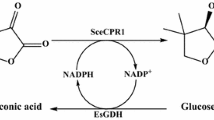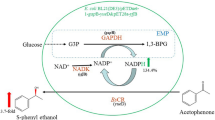Abstract
Both Sys1 and Sygdh, two codon-optimized genes encoding SyS1 and SyGDH, were synthesized based on the carbonyl reductase (S1) and glucose 1-dehydrogenase (GDH) gene sequences, respectively, from Candida magnoliae and Thermoplasma acidophilum, and co-expressed in Escherichia coli BL21(DE3) using two strategies. One strategy involved a recombinant E. coli strain (E. coli/Sygdh-Sys1) constructed by transforming a recombinant plasmid, pETDuet-Sygdh-Sys1, into E. coli BL21. The other strategy involved another recombinant E. coli strain (E. coli/Sys1/Sygdh) obtained by co-transforming the recombinant plasmids pET-22b-Sys1 and pET-28a-Sygdh into E. coli BL21. The enzyme activity assays indicated that the activities of recombinant SyS1 and SyGDH (3.7 and 56.3 U/g wet cells) expressed in E. coli/Sygdh-Sys1 were higher than those (2.8 and 44.1 U/g wet cells) in E. coli/Sys1/Sygdh. Accordingly, E. coli/Sygdh-Sys1 was chosen, and its whole cells were used as catalysts for the asymmetric reduction of m-chlorophenacyl chloride (m-CPC) to the corresponding (R)-2-chloro-1-(3-chlorophenyl)ethanol [(R)-CCE] coupled with the regeneration of NADPH in situ. Under the optimized reaction conditions of 30 mM m-CPC, 50 mg/ml wet cells, 40 mM glucose and 0.2 mM NADP+ at pH 7.0 and 35 °C for 3 h, (R)-CCE was obtained with a molar yield of 99.2 % and an enantiomeric excess (e.e.) value of more than 99 %.







Similar content being viewed by others
References
Berenguer-Murcia A, Fernandez-Lafuente R (2010) New trends in the recycling of NAD(P)H for the design of sustainable asymmetric reductions catalyzed by dehydrogenases. Curr Org Chem 14:1000–1021
Bloom JD, Dutia MD, Johnson BD, Wissner A, Burns MG, Largis EE, Dolan JA, Claus TH (1992) Disodium (R, R)-5-[2-[[2-(3-chlorophenyl)-2-hydroxyethyl]-amino]propyl]-1,3-benzodioxole-2,2-dicarboxylate (CL 316,243). A potent β-adrenergic agonist virtually specific for β3 receptors. A promising antidiabetic and antiobesity agent. J Med Chem 35:3081–3084
Hamada H, Miura T, Kumobayashi H, Matsuda T, Harada T, Nakamura K (2001) Asymmetric synthesis of (R)-2-chloro-1-(m-chlorophenyl)ethanol using acetone powder of Geotrichum candidum. Biotechnol Lett 23:1603–1606
Huisman GW, Collier SJ (2013) On the development of new biocatalytic processes for practical pharmaceutical synthesis. Curr Opin Chem Biol 17:284–292
Itoh N, Matsuda M, Mabuchi M, Dairi T, Wang JC (2002) Chiral alcohol production by NADH-dependent phenylacetaldehyde reductase coupled with in situ regeneration of NADH. Eur J Biochem 269:2394–2402
Kizaki N, Yasohara Y, Hasegawa J, Wada M, Kataoka M, Shimizu S (2001) Synthesis of optically pure ethyl (S)-4-chloro-3-hydroxybutanoate by Escherichia coli transformant cells coexpressing the carbonyl reductase and glucose dehydrogenase genes. Appl Microbiol Biotechnol 55:590–595
Laemmli UK (1970) Cleavage of structural proteins during the assembly of the head of bacteriophage T4. Nature 227:680–685
Liang J, Lalonde J, Borup B, Mitchell V, Mundorff E, Trinh N, Kochrekar DA, Cherat RN, Pai GG (2010) Development of a biocatalytic process as an alternative to the (−)-DIP-Cl-mediated asymmetric reduction of a key intermediate of montelukast. Org Process Res Dev 14:193–198
Lin H, Chen YZ, Xu XY, Xia SW, Wang LX (2009) Preparation of key intermediates of adrenergic receptor agonists: Highly enantioselective production of (R)-α-halohydrins with Saccharomyces cerevisiae CGMCC 2.396. J Mol Catal B Enzym 57:1–5
Ni Y, Xu JH (2012) Biocatalytic ketone reduction: a green and efficient access to enantiopure alcohols. Biotechnol Adv 30:1279–1288
Ni Y, Zhang BH, Sun ZH (2012) Efficient synthesis of (R)-2-chloro-1-(3-chlorophenyl)ethanol by permeabilized whole-cells of Candida ontarioensis. Chin J Catal 33:681–687
Ohkuma T, Tsutsumi K, Utsumi N, Arai N, Noyori R, Murata K (2007) Asymmetric hydrogenation of α-chloro aromatic ketones catalyzed by η 6-arene/TsDPEN–Ruthenium(II) complexes. Org Lett 9:255–257
Ren J, Dong WY, Yu BQ, Wu QQ, Zhu DM (2012) Synthesis of optically active α-bromohydrins via reduction of α-bromoacetophenone analogues catalyzed by an isolated carbonyl reductase. Tetrahedron Asymmetry 23:497–500
Smith LD, Budgen N, Bungard SJ, Danson MJ, Hough DW (1989) Purification and characterization of glucose dehydrogenase from the thermoacidophilic archaebacterium Thermoplasma acidophilum. Biochem J 261:973–977
Solano DM, Hoyos P, Hernáiz MJ, Alcántara AR, Sánchez-Montero JM (2012) Industrial biotransformations in the synthesis of building blocks leading to enantiopure drugs. Bioresour Technol 115:196–207
Su YN, Ni Y, Wang JC, Xu ZH, Sun ZH (2012) Two-enzyme coexpressed recombinant strain for asymmetric synthesis of ethyl (R)-2-hydroxy-4-phenylbutyrate. Chin J Catal 33:1650–1660
Wu XR, Jiang JP, Chen YJ (2011) Correlation between intracellular cofactor concentrations and biocatalytic efficiency: coexpression of diketoreductase and glucose dehydrogenase for the preparation of chiral diol for statin drugs. ACS Catal 1:1661–1664
Xia SW, Lin H, Chen YZ (2012) Preparation of (R)-2-chloro-1-(m-chlorophenyl)ethanol by Lipozyme TL IM-catalyzed second resolution. Chin Chem Lett 23:289–292
Yasohara Y, Kizaki N, Hasegawa J, Wada M, Kataoka M, Shimizu S (2000) Molecular cloning and overexpression of the gene encoding an NADPH-dependent carbonyl reductase gene from Candida magnoliae, invoved in stereoselective reduction of ethyl 4-chloro-3-oxobutanoate. Biosci Biotechnol Biochem 64:1430–1436
Zhang JD, Li AT, Yu HL, Imanaka T, Xu JH (2011) Synthesis of optically pure S-sulfoxide by Escherichia coli transformant cells coexpressing the P450 monooxygenase and glucose dehydrogenase genes. J Ind Microbiol Biotechnol 38:633–641
Zhang HM, Wang JQ, Wu MC, Gao SJ, Li JF, Yang YJ (2014) Optimized expression, purification and characterization of a family 11 xylanase (AuXyn11A) from Aspergillus usamii E001 in Pichia pastoris. J Sci Food Agric 94:699–706
Zhou CY, Bai JY, Deng SS, Wang J, Zhu J, Wu MC, Wang W (2008) Cloning of a xylanase gene from Aspergillus usamii and its expression in Escherichia coli. Bioresour Technol 99:831–838
Zhu DM, Yang Y, Hua L (2006) Stereoselective enzymatic synthesis of chiral alcohols with the use of a carbonyl reductase from Candida magnoliae with anti-Prelog enantioselectivity. J Org Chem 71:4202–4205
Acknowledgments
This work was financially supported by the National Nature Science Foundation of China (No. 31271811), Fundamental Research Funds for the Central Universities of China (JUSRP51412B), and Postgraduate Innovation Training Project of Jiangsu, China (No. CXZZ13_0757). We are grateful to Prof. Xianzhang Wu (School of Biotechnology, Jiangnan University) for providing technical assistance.
Author information
Authors and Affiliations
Corresponding author
Additional information
Tao Yu and Jian-Fang Li, the two first authors, contributed equally to this work.
Electronic supplementary material
Below is the link to the electronic supplementary material.
ESM 1
(DOC 58 kb)
Rights and permissions
About this article
Cite this article
Yu, T., Li, JF., Zhu, LJ. et al. Reduction of m-chlorophenacyl chloride coupled with regeneration of NADPH by recombinant Escherichia coli cells co-expressing both carbonyl reductase and glucose 1-dehydrogenase. Ann Microbiol 66, 343–350 (2016). https://doi.org/10.1007/s13213-015-1114-1
Received:
Accepted:
Published:
Issue Date:
DOI: https://doi.org/10.1007/s13213-015-1114-1




